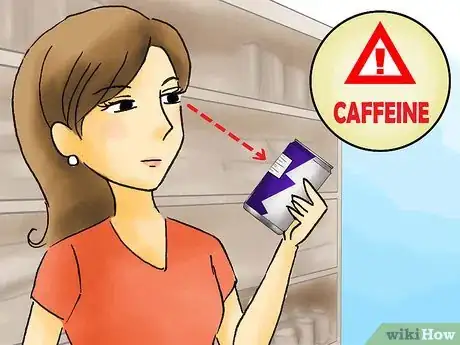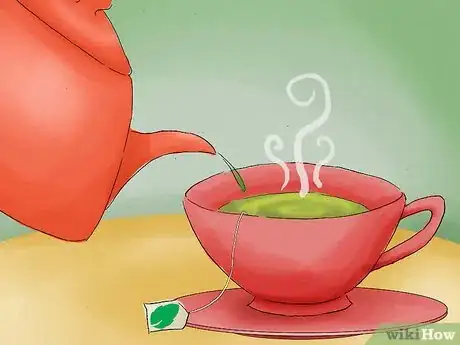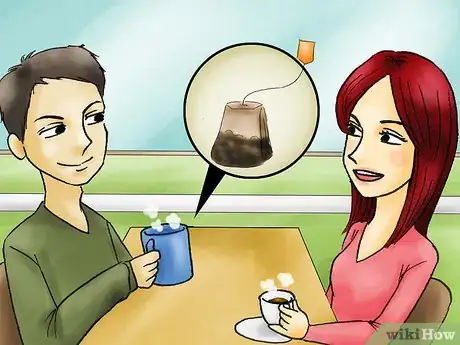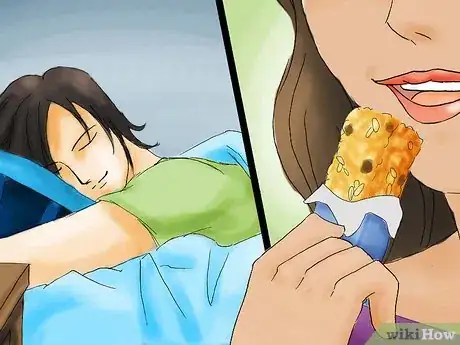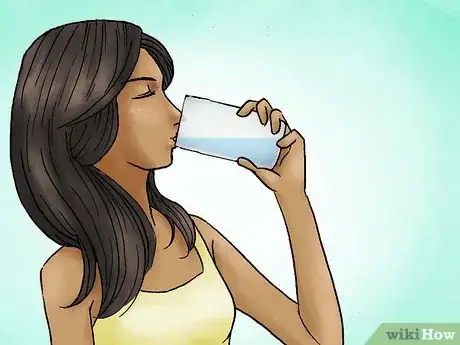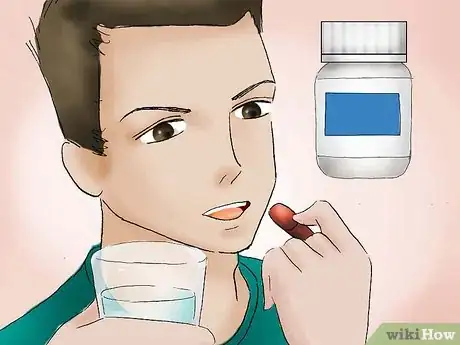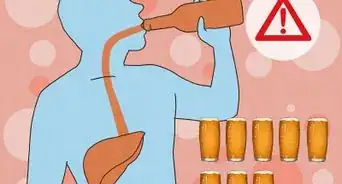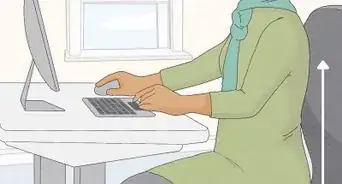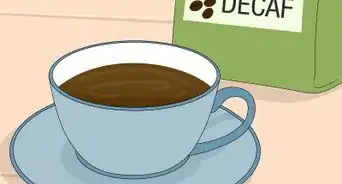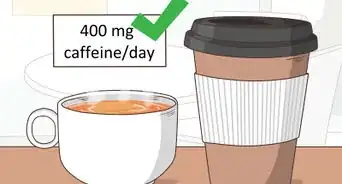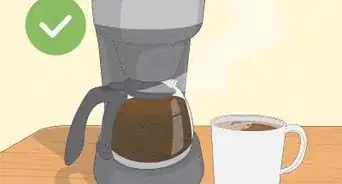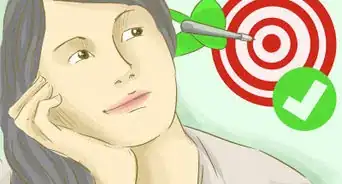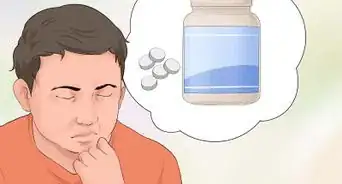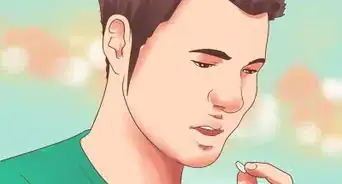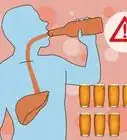This article was medically reviewed by Sarah Gehrke, RN, MS. Sarah Gehrke is a Registered Nurse and Licensed Massage Therapist in Texas. Sarah has over 10 years of experience teaching and practicing phlebotomy and intravenous (IV) therapy using physical, psychological, and emotional support. She received her Massage Therapist License from the Amarillo Massage Therapy Institute in 2008 and a M.S. in Nursing from the University of Phoenix in 2013.
There are 15 references cited in this article, which can be found at the bottom of the page.
This article has been viewed 118,514 times.
Caffeine is a drug and can be highly addictive. If you're tired of relying on coffee or energy drinks to get through the day, there are ways to cut back on caffeine. Start tapering off caffeine gradually. Adjust your life as necessary. You may, for example, have to opt for decaf beverages during social settings. You can expect a headache and other symptoms of withdrawal, so manage those accordingly to stay on track.
Steps
Cutting Back Gradually
-
1Keep tabs on your overall caffeine consumption. The first step to breaking the cycle of caffeine addiction is to identify how much you're consuming. This way, you can get a sense of how much to cut back each week to gradually taper off caffeine.[1]
- Read labels when you consume a caffeinated beverage. Write down how much caffeine you're consuming, and also keep track of, say, how many cups of coffee or soda you have each day.
- Some surprising foods, like chocolate, contain trace amounts of caffeine. Be sure to read all nutritional labels, even for foods you assume are not caffeinated.
-
2Set goals for yourself. Quitting caffeine takes a lot of commitment, so set small goals for yourself along the way. Make a schedule with milestones to reach by a particular date. If you make small goals over time, you will feel a sense of accomplishment that will keep you going.[2]
- You can aim to get down to a certain amount of coffee in, say, a month. A goal could be something like, "Reduce caffeine intake to one cup a day by March 1st."
- Have small goals along the way. For example, "Skip the afternoon coffee three days this week."
Advertisement -
3Cut back gradually. Set reasonable goals for yourself. You're unlikely to, say, halve your caffeine consumption in a single week. Instead, work on lessening the amount you drink each week in tiny increments.[3]
- If you're a coffee drinker, try drinking 1/4 less cup of coffee each week. If you prefer soda or energy drinks, try eliminating half a can every two days. Pick an amount to cut back that feels reasonable to you and proceed from there.
-
4Look for hidden sources of caffeine. Caffeine is everywhere. In addition to being in surprising food sources, you can find it in certain medications. If you're reaching for an over-the-counter painkiller to alleviate caffeine withdrawal, make sure your chosen painkiller isn't loaded with caffeine.[4]
- Teas, coffees, energy drinks, and sodas are the most obvious sources of caffeine.
- You may also find caffeine in unusual places. Protein or diet bars, coffee flavored ice creams, migraine medications, and chocolate may contain caffeine.
-
5Replace a small amount of regular coffee with decaf coffee. In the morning when you prepare your coffee pot, mix half and half decaf grounds or beans with regular grounds or beans. This way, even if you drink more coffee than you intended, you're still not getting as much caffeine.
Adjusting Your Day-to-Day Life
-
1Drink green tea. Green tea does have some caffeine, but not as much as things like coffee, soda, and energy drinks. If you're feeling the need for an afternoon pick-me-up, opt for a green tea over a coffee or soda. This will keep you going while still reducing your overall intake of caffeine.[5]
- You can also try switching out coffee for green tea throughout the day. For example, have four cups of green tea instead of four cups of coffee. Once you feel comfortable drinking tea, reduce the amount of tea you consume.
-
2Opt for decaf. You may enjoy the taste of coffee, soda, and other caffeinated beverages. If you have a soda in the afternoon as a treat, go for decaf soda. If you love the taste of fresh coffee, start buying decaffeinated blends. This will help you stay on track with your goals while not sacrificing the drinks you love.[6]
- Decaf may still contain a small amount of caffeine.[7]
-
3
-
4Socialize without caffeine. Caffeine is often a major component in socialization. You may, for example, meet a friend at a coffee house in the afternoon. Look for ways to socialize with others without consuming caffeine.[10]
- If you meet your friends at a coffee house, opt for herbal teas, which do not contain caffeine.
- You can also find places that specialize in herbal tea. Going to a coffee place for tea can be disappointing, as tea-based drinks may not be as flavorful. If a friend wants to meet up at a coffee house, try to find a place that specializes in tea as well.
-
5Find substitutes for your favorite caffeinated beverages. For many people, milky lattes and cappuccinos are a nice indulgence. You may, for example, treat yourself to a pricey latte on the weekends. You can still have these treats on occasion. However, work on altering them to consume less caffeine.[11]
- The most obvious way to do this is to order a decaf variety of your go-to coffee shop treat. For the most part, workers should be able to accommodate this request. Many coffee houses can also make "half-caf" beverages, where they use half decaf coffee or espresso with half regular coffee or espresso; this is a great option if you're still cutting back on caffeine.
- If you can't get a decaf version for whatever reason, see if there are any drinks without added caffeine on the menu. A cup of hot cocoa, for example, can be as satisfying as a latte. Cocoa does contain small amounts of caffeine, but much less than coffee. You can also order a "steamer," which is hot milk mixed with a syrup or sweetener of your choice, like vanilla or honey.
- If you're a soda drinker, substitute sparkling water for soda.
-
6Rely on protein or naps to address afternoon fatigue. You may find yourself reaching for caffeine in the afternoon. There are other healthier ways to wake your body up, however. Instead of going for a cup of coffee, have something small to eat[12] or take a brief nap.
- If you're able, take a nap for about 20 minutes. This will leave you feeling rested and refreshed. However, be sure to set an alarm. Many people end up accidentally napping for over an hour.
- Try a small energizing snack. Healthy proteins can boost your energy as much as, or even more than, caffeine. Have a small slice of turkey or a cup of nuts instead of reaching for the coffee. Also, avoiding processed carbs at lunch can help reduce afternoon fatigue.
Managing Withdrawal Symptoms
-
1Make sure you're not cutting your caffeine intake too fast. If you're experiencing heavy withdrawal symptoms, you may have cut back too fast. Try adding back in a small amount of caffeine during the day. This may reduce withdrawal. After a few days, taper back a little again. Remember, caffeine is a drug. Cutting back too fast can cause unsavory physical symptoms.[13]
-
2Have patience. At first, withdrawal symptoms may seem unbearable. However, keep in mind they are temporary.[14] Remind yourself of all the benefits you're getting from lessening your reliance on caffeine. You will be saving money and improving your health. Give it time and it will get easier.
-
3Stay hydrated. Since heavy caffeine users often get their fix through drinks like coffee or soda, cutting out caffeine means you'll be cutting out some of the major sources of water in your diet. Be sure to replace this with other liquids like water, herbal teas, or diluted juices.
- Drinking water throughout the day can help you stay more alert. It also gives you something to do with your hands besides drinking coffee. Instead of having a thermos or mug by your side, have a bottle of water.[15]
-
4Try peppermint for withdrawal headaches. If you're feeling a caffeine headache coming on, try using peppermint. The scent and taste of peppermint may reduce headaches, lessening the symptoms of caffeine withdrawal.[16]
- Try dabbing some peppermint scented lotion or perfume behind your ears or on your wrists.
- Have a peppermint flavored candy, chew peppermint gum, or drink a cup of peppermint tea.
-
5Use over-the-counter pain relievers. As long as they don't contain caffeine, you can use pain relievers to address issues like headaches. Keep some on hand throughout the day and take them as needed.[17]
- Make sure to follow the directions on the bottle. Some pain killers should not be taken in large amounts throughout the day. Stick to the recommended dosage.
- Talk to your doctor about taking over-the-counter medication if you're on any medications currently.
Expert Q&A
-
QuestionWhat can I take for withdrawal headaches besides Tylenol or Advil?
 Sarah Gehrke, RN, MSSarah Gehrke is a Registered Nurse and Licensed Massage Therapist in Texas. Sarah has over 10 years of experience teaching and practicing phlebotomy and intravenous (IV) therapy using physical, psychological, and emotional support. She received her Massage Therapist License from the Amarillo Massage Therapy Institute in 2008 and a M.S. in Nursing from the University of Phoenix in 2013.
Sarah Gehrke, RN, MSSarah Gehrke is a Registered Nurse and Licensed Massage Therapist in Texas. Sarah has over 10 years of experience teaching and practicing phlebotomy and intravenous (IV) therapy using physical, psychological, and emotional support. She received her Massage Therapist License from the Amarillo Massage Therapy Institute in 2008 and a M.S. in Nursing from the University of Phoenix in 2013.
Registered Nurse Taking a nap or using essential oils is a start. Oils include peppermint, ginger, lavender, and eucalyptus. Self head massage with the oils may be beneficial. You can also try herbal teas, e.g., chamomile, basil, and peppermint. Medicinal mushrooms such as reishi may be good to have on board. Wear sunglasses during the day or if you work in an office you may want to try gaming glasses to limit computer stimulation. Aspirin is an OTC remedy (not for children or teens). Be sure and take in enough water, whole foods, and carbs for the day.
Taking a nap or using essential oils is a start. Oils include peppermint, ginger, lavender, and eucalyptus. Self head massage with the oils may be beneficial. You can also try herbal teas, e.g., chamomile, basil, and peppermint. Medicinal mushrooms such as reishi may be good to have on board. Wear sunglasses during the day or if you work in an office you may want to try gaming glasses to limit computer stimulation. Aspirin is an OTC remedy (not for children or teens). Be sure and take in enough water, whole foods, and carbs for the day. -
QuestionIs it possible too much caffeine is contributing to my aching joints and knee pain?
 Sarah Gehrke, RN, MSSarah Gehrke is a Registered Nurse and Licensed Massage Therapist in Texas. Sarah has over 10 years of experience teaching and practicing phlebotomy and intravenous (IV) therapy using physical, psychological, and emotional support. She received her Massage Therapist License from the Amarillo Massage Therapy Institute in 2008 and a M.S. in Nursing from the University of Phoenix in 2013.
Sarah Gehrke, RN, MSSarah Gehrke is a Registered Nurse and Licensed Massage Therapist in Texas. Sarah has over 10 years of experience teaching and practicing phlebotomy and intravenous (IV) therapy using physical, psychological, and emotional support. She received her Massage Therapist License from the Amarillo Massage Therapy Institute in 2008 and a M.S. in Nursing from the University of Phoenix in 2013.
Registered Nurse Caffeine may cause joint and muscle pain in some people or it may aggravate underlying conditions that may contribute to joint pain, i.e., fibromyalgia or drug interaction. One way to test if caffeine is the culprit is to do an elimination test. Once you eliminate caffeine, monitor your symptoms (it's helpful to keep a diary or download a food-symptom tracker app). It may take a few days for the inflammation to subside in order to determine if the caffeine is causing the pain. If you put dairy in your coffee, that is also something you may want to take another look at. You can also visit with your doctor, especially if the pain is increasing or if you cannot figure out what is causing it.
Caffeine may cause joint and muscle pain in some people or it may aggravate underlying conditions that may contribute to joint pain, i.e., fibromyalgia or drug interaction. One way to test if caffeine is the culprit is to do an elimination test. Once you eliminate caffeine, monitor your symptoms (it's helpful to keep a diary or download a food-symptom tracker app). It may take a few days for the inflammation to subside in order to determine if the caffeine is causing the pain. If you put dairy in your coffee, that is also something you may want to take another look at. You can also visit with your doctor, especially if the pain is increasing or if you cannot figure out what is causing it.
Warnings
- If you are going through caffeine withdrawal, you may feel anxious or nervous.⧼thumbs_response⧽
References
- ↑ http://www.mayoclinic.org/healthy-lifestyle/nutrition-and-healthy-eating/in-depth/caffeine/art-20045678?pg=2
- ↑ http://blog.myfitnesspal.com/so-you-want-to-stop-drinking-caffeine/
- ↑ https://my.clevelandclinic.org/health/articles/15496-caffeine-how-to-hack-it-and-how-to-quit-it
- ↑ http://www.mayoclinic.org/healthy-lifestyle/nutrition-and-healthy-eating/in-depth/caffeine/art-20045678?pg=2
- ↑ https://betterhumans.pub/how-to-quit-caffeine-in-one-week-e041892698ec
- ↑ http://www.mayoclinic.org/healthy-lifestyle/nutrition-and-healthy-eating/in-depth/caffeine/art-20045678?pg=2
- ↑ https://www.ncbi.nlm.nih.gov/pubmed/17132260
- ↑ http://my.chriskresser.com/the-supplement-guide/
- ↑ https://www.ncbi.nlm.nih.gov/pubmed/24266378
- ↑ https://www.coffeeandhealth.org/all-about-coffee/coffee-socialising/
- ↑ https://www.epicurious.com/expert-advice/5-alternatives-to-coffee-that-actually-taste-good-article
- ↑ https://www.betterhealth.vic.gov.au/health/conditionsandtreatments/fatigue-fighting-tips
- ↑ https://health.clevelandclinic.org/quitting-caffeine-the-headache-free-way/
- ↑ https://my.clevelandclinic.org/health/articles/15496-caffeine-how-to-hack-it-and-how-to-quit-it
- ↑ http://www.health.com/health/gallery/0,,20576536,00.html#drink-more-water-3
- ↑ https://www.webmd.com/migraines-headaches/nontraditional-headache-treatments
- ↑ https://emedicine.medscape.com/article/792384-medication



